El Niño Magnitude and Western Pacific Warm Pool Displacement. Part I: Historical Insights from CMIP6 Models
Abstract
1. Introduction
2. Materials and Methods
3. Results
3.1. Magnitude of El Niño Events in Historical Climate Simulations
3.2. WPWP in Historical Climate Simulations
3.3. Relationship Between El Niño Magnitude and Displacement of the WPWP
4. Discussion and Conclusions
Author Contributions
Funding
Institutional Review Board Statement
Informed Consent Statement
Data Availability Statement
Acknowledgments
Conflicts of Interest
References
- Ropelewski, C.F.; Halpert, M.S. Global and regional scale precipitation patterns associated with the El Niño/Southern Oscillation. Mon. Weather Rev. 1987, 115, 1606–1626. [Google Scholar] [CrossRef]
- Ronghui, H.; Yifang, W. The influence of ENSO on the summer climate change in China and its mechanism. Adv. Atmos. Sci. 1989, 6, 21–32. [Google Scholar] [CrossRef]
- Zhang, R.; Sumi, A.; Kimoto, M. Impact of El Niño on the East Asian monsoon a diagnostic study of the ’86/87 and ’91/92 events. J. Meteorol. Soc. Japan. Ser. II 1996, 74, 49–62. [Google Scholar] [CrossRef]
- Wang, B.; Wu, R.; Fu, X. Pacific–East Asian teleconnection: How does ENSO affect East Asian climate? J. Clim. 2000, 13, 1517–1536. [Google Scholar] [CrossRef]
- Neelin, J.; Chou, C.; Su, H. Tropical drought regions in global warming and El Niño teleconnections. Geophys. Res. Lett. 2003, 30, 2273. [Google Scholar] [CrossRef]
- Chiodi, A.M.; Harrison, D.E. El Niño impacts on seasonal US atmospheric circulation, temperature, and precipitation anomalies: The OLR-event perspective. J. Clim. 2013, 26, 822–837. [Google Scholar] [CrossRef]
- Lu, B.; Li, H.; Wu, J.; Zhang, T.; Liu, J.; Liu, B.; Chen, Y.; Baishan, J. Impact of El Niño and Southern Oscillation on the summer precipitation over Northwest China. Atmos. Sci. Lett. 2019, 20, e928. [Google Scholar] [CrossRef]
- Alizadeh, O. A review of ENSO teleconnections at present and under future global warming. Wiley Interdiscip. Rev. Clim. Change 2024, 15, e861. [Google Scholar] [CrossRef]
- McPhaden, M.J.; Zebiak, S.E.; Glantz, M.H. ENSO as an integrating concept in earth science. Science 2006, 314, 1740–1745. [Google Scholar] [CrossRef]
- Cai, W.; McPhaden, M.J.; Grimm, A.M.; Rodrigues, R.R.; Taschetto, A.S.; Garreaud, R.D.; Dewitte, B.; Poveda, G.; Ham, Y.-G.; Santoso, A. Climate impacts of the El Niño–southern oscillation on South America. Nat. Rev. Earth Environ. Health 2020, 1, 215–231. [Google Scholar] [CrossRef]
- Goddard, L.; Gershunov, A. Impact of El Niño on weather and climate extremes. In El Niño Southern Oscillation in a Changing Climate; Wiley: Hoboken, NJ, USA, 2020; pp. 361–375. [Google Scholar]
- Liu, Y.; Cai, W.; Lin, X.; Li, Z.; Zhang, Y. Nonlinear El Niño impacts on the global economy under climate change. Nat. Commun. 2023, 14, 5887. [Google Scholar] [CrossRef] [PubMed]
- Marjani, S.; Alizadeh-Choobari, O.; Irannejad, P. Frequency of extreme El Niño and La Niña events under global warming. Clim. Dyn. 2019, 53, 5799–5813. [Google Scholar] [CrossRef]
- Alizadeh, O. A review of the El Niño-Southern Oscillation in future. Earth Sci. Rev. 2022, 235, 104246. [Google Scholar] [CrossRef]
- Deser, C.; Phillips, A.S.; Tomas, R.A.; Okumura, Y.M.; Alexander, M.A.; Capotondi, A.; Scott, J.D.; Kwon, Y.-O.; Ohba, M. ENSO and Pacific decadal variability in the Community Climate System Model version 4. J. Clim. 2012, 25, 2622–2651. [Google Scholar] [CrossRef]
- Eyring, V.; Bony, S.; Meehl, G.A.; Senior, C.A.; Stevens, B.; Stouffer, R.J.; Taylor, K.E. Overview of the Coupled Model Intercomparison Project Phase 6 (CMIP6) experimental design and organization. Geosci. Model Dev. 2016, 9, 1937–1958. [Google Scholar] [CrossRef]
- Capotondi, A.; Deser, C.; Phillips, A.; Okumura, Y.; Larson, S. ENSO and Pacific decadal variability in the Community Earth System Model version 2. J. Adv. Model. Earth Syst. 2020, 12, e2019MS002022. [Google Scholar] [CrossRef]
- Fredriksen, H.B.; Berner, J.; Subramanian, A.C.; Capotondi, A. How does El Niño–Southern Oscillation change under global warming—A first look at CMIP6. Geophys. Res. Lett. 2020, 47, e2020GL090640. [Google Scholar] [CrossRef]
- Sun, Y.; Sun, D.-Z.; Wu, L.; Wang, F. Western Pacific warm pool and ENSO asymmetry in CMIP3 models. Adv. Atmos. Sci. 2013, 30, 940–953. [Google Scholar] [CrossRef]
- Zhang, T.; Sun, D.-Z. ENSO asymmetry in CMIP5 models. J. Clim. 2014, 27, 4070–4093. [Google Scholar] [CrossRef]
- Sun, Y.; Wang, F.; Sun, D.-Z. Weak ENSO asymmetry due to weak nonlinear air–sea interaction in CMIP5 climate models. Adv. Atmos. Sci. 2016, 33, 352–364. [Google Scholar] [CrossRef]
- Hayashi, M.; Jin, F.-F.; Stuecker, M.F. Dynamics for El Niño-La Niña asymmetry constrain equatorial-Pacific warming pattern. Nat. Commun. 2020, 11, 4330. [Google Scholar] [CrossRef] [PubMed]
- Zhao, Y.; Sun, D.-Z. ENSO asymmetry in CMIP6 models. J. Clim. 2022, 35, 5555–5572. [Google Scholar] [CrossRef]
- Chen, S.; Yu, B.; Chen, W. An analysis on the physical process of the influence of AO on ENSO. Clim. Dyn. 2014, 42, 973–989. [Google Scholar] [CrossRef]
- Chen, S.; Chen, W.; Zhou, W.; Wu, R.; Ding, S.; Chen, L.; He, Z.; Yang, R. Interdecadal variation in the impact of Arctic sea ice on El Niño–southern oscillation: The role of atmospheric mean flow. J. Clim. 2024, 37, 5483–5506. [Google Scholar] [CrossRef]
- Chen, S.; Chen, W.; Wu, R.; Yu, B.; Graf, H.-F.; Cai, Q.; Ying, J.; Xing, W. Atlantic multidecadal variability controls Arctic-ENSO connection. NPJ Clim. Atmos. Sci. Lett. 2025, 8, 44. [Google Scholar] [CrossRef]
- Pierrehumbert, R.T. Thermostats, Radiator Fins, and the Local Runaway Greenhouse. J. Atmos. Sci. 1995, 52, 1784–1806. [Google Scholar] [CrossRef]
- Sun, D.-Z. A possible effect of an increase in the warm-pool SST on the magnitude of El Niño warming. J. Clim. 2003, 16, 185–205. [Google Scholar] [CrossRef]
- Chen, H.; Shi, J.; Jin, Y.; Geng, T.; Li, C.; Zhang, X. Warm and cold episodes in western Pacific warm pool and their linkage with ENSO asymmetry and diversity. J. Geophys. Res. Oceans 2021, 126, e2021JC017287. [Google Scholar] [CrossRef]
- Fu, S.; Hu, S.; Zheng, X.-T. Collaborative role of warm pool edge and ocean heat content in El Niño development: Implications for the 1982/83 extreme El Niño. Clim. Dyn. 2024, 62, 7701–7716. [Google Scholar] [CrossRef]
- Hoyos, C.D.; Webster, P.J. Evolution and modulation of tropical heating from the last glacial maximum through the twenty-first century. Clim. Dyn. 2012, 38, 1501–1519. [Google Scholar] [CrossRef]
- Mechoso, C.R.; Robertson, A.W.; Barth, N.; Davey, M.K.; Delecluse, P.; Gent, P.R.; Ineson, S.; Kirtman, B.; Latif, M.; Treut, H.L.; et al. The Seasonal Cycle over the Tropical Pacific in Coupled Ocean–Atmosphere General Circulation Models. Mon. Weather Rev. 1995, 123, 2825–2838. [Google Scholar] [CrossRef]
- Kiehl, J.T. Simulation of the Tropical Pacific Warm Pool with the NCAR Climate System Model. J. Clim. 1998, 11, 1342–1355. [Google Scholar] [CrossRef]
- Kim, W.; Cai, W. The importance of the eastward zonal current for generating extreme El Niño. Clim. Dyn. 2014, 42, 3005–3014. [Google Scholar] [CrossRef]
- Wyrtki, K. Water displacements in the Pacific and the genesis of El Niño cycles. J. Geophys. Res. Oceans 1985, 90, 7129–7132. [Google Scholar] [CrossRef]
- Picaut, J.; Ioualalen, M.; Menkès, C.; Delcroix, T.; Mcphaden, M.J. Mechanism of the zonal displacements of the Pacific warm pool: Implications for ENSO. Science 1996, 274, 1486–1489. [Google Scholar] [CrossRef]
- Hu, S.; Hu, D. Heat center of the western Pacific warm pool. Chin. J. Oceanol. Limnol. Oceanogr. Bull. 2012, 30, 169–176. [Google Scholar] [CrossRef]
- Eisenman, I.; Yu, L.; Tziperman, E. Westerly wind bursts: ENSO’s tail rather than the dog? J. Clim. 2005, 18, 5224–5238. [Google Scholar] [CrossRef]
- Williams, I.N.; Patricola, C.M. Diversity of ENSO events unified by convective threshold sea surface temperature: A nonlinear ENSO index. Geophys. Res. Lett. 2018, 45, 9236–9244. [Google Scholar] [CrossRef]
- Okumura, Y.M. ENSO diversity from an atmospheric perspective. Curr. Clim. Change Rep. 2019, 5, 245–257. [Google Scholar] [CrossRef]
- Brown, J.R.; Brierley, C.M.; An, S.-I.; Guarino, M.-V.; Stevenson, S.; Williams, C.J.; Zhang, Q.; Zhao, A.; Abe-Ouchi, A.; Braconnot, P. Comparison of past and future simulations of ENSO in CMIP5/PMIP3 and CMIP6/PMIP4 models. Clim. Past 2020, 16, 1777–1805. [Google Scholar] [CrossRef]
- Grose, M.R.; Narsey, S.; Delage, F.; Dowdy, A.J.; Bador, M.; Boschat, G.; Chung, C.; Kajtar, J.; Rauniyar, S.; Freund, M. Insights from CMIP6 for Australia’s future climate. Earth’s Future 2020, 8, e2019EF001469. [Google Scholar] [CrossRef]
- Tian, B.; Dong, X. The double—ITCZ bias in CMIP3, CMIP5, and CMIP6 models based on annual mean precipitation. Geophys. Res. Lett. 2020, 47, e2020GL087232. [Google Scholar] [CrossRef]
- Lee, J.; Planton, Y.Y.; Gleckler, P.J.; Sperber, K.R.; Guilyardi, E.; Wittenberg, A.T.; McPhaden, M.J.; Pallotta, G.J.G.R.L. Robust evaluation of ENSO in climate models: How many ensemble members are needed? Geophys. Res. Lett. 2021, 48, e2021GL095041. [Google Scholar] [CrossRef]
- Planton, Y.Y.; Guilyardi, E.; Wittenberg, A.T.; Lee, J.; Gleckler, P.J.; Bayr, T.; McGregor, S.; McPhaden, M.J.; Power, S.; Roehrig, R. Evaluating climate models with the CLIVAR 2020 ENSO metrics package. Bull. Am. Meteorol. Soc. 2021, 102, E193–E217. [Google Scholar] [CrossRef]
- Rayner, N.; Parker, D.E.; Horton, E.; Folland, C.K.; Alexander, L.V.; Rowell, D.; Kent, E.C.; Kaplan, A. Global analyses of sea surface temperature, sea ice, and night marine air temperature since the late nineteenth century. J. Geophys. Res. Atmos. 2003, 108, 4407. [Google Scholar] [CrossRef]
- Cai, W.; Wang, G.; Dewitte, B.; Wu, L.; Santoso, A.; Takahashi, K.; Yang, Y.; Carréric, A.; McPhaden, M.J. Increased variability of eastern Pacific El Niño under greenhouse warming. Nature 2018, 564, 201–206. [Google Scholar] [CrossRef]
- Geng, T.; Jia, F.; Cai, W.; Wu, L.; Gan, B.; Jing, Z.; Li, S.; McPhaden, M.J. Increased occurrences of consecutive La Niña events under global warming. Nature 2023, 619, 774–781. [Google Scholar] [CrossRef]
- Sun, D.-Z.; Zhang, T. A regulatory effect of ENSO on the time-mean thermal stratification of the equatorial upper ocean. Geophys. Res. Lett. 2006, 33, L07710. [Google Scholar] [CrossRef]
- Sun, D.-Z. The Role of El Niño—Southern Oscillation in Regulating its Background State. In Nonlinear Dynamics in Geosciences; Springer: Berlin/Heidelberg, Germany, 2007; pp. 537–555. [Google Scholar]
- Liang, J.; Yang, X.-Q.; Sun, D.-Z. The effect of ENSO events on the tropical Pacific mean climate: Insights from an analytical model. J. Clim. 2012, 25, 7590–7606. [Google Scholar] [CrossRef]
- Sun, D.-Z.; Zhang, T.; Sun, Y.; Yu, Y. Rectification of El Niño–Southern Oscillation into climate anomalies of decadal and longer time scales: Results from forced ocean GCM experiments. J. Clim. 2014, 27, 2545–2561. [Google Scholar] [CrossRef]
- Burgers, G.; Stephenson, D.B. The “Normality” of El Niño. Geophys. Res. Lett. 1999, 26, 1027–1030. [Google Scholar] [CrossRef]
- Liang, J.; Yang, X.-Q.; Sun, D.-Z. Factors determining the asymmetry of ENSO. J. Clim. 2017, 30, 6097–6106. [Google Scholar] [CrossRef]
- Gu, Z.; Sun, D.-Z. El Niño Magnitude and Western Pacific Warm Pool Displacement. Part II: Future Changes Under Global Warming. Climate 2025, 13, 97. [Google Scholar] [CrossRef]
- Sun, D.-Z.; Fasullo, J.; Zhang, T.; Roubicek, A. On the radiative and dynamical feedbacks over the equatorial Pacific cold tongue. J. Clim. 2003, 16, 2425–2432. [Google Scholar] [CrossRef]
- Sun, D.-Z.; Zhang, T.; Covey, C.; Klein, S.; Collins, W.; Hack, J.; Kiehl, J.; Meehl, G.; Held, I.; Suarez, M. Radiative and dynamical feedbacks over the equatorial cold tongue: Results from nine atmospheric GCMs. J. Clim. 2006, 19, 4059–4074. [Google Scholar] [CrossRef]
- Jiang, W.; Huang, P.; Huang, G.; Ying, J. Origins of the excessive westward extension of ENSO SST simulated in CMIP5 and CMIP6 models. J. Clim. 2021, 34, 2839–2851. [Google Scholar] [CrossRef]
- Picaut, J.; Masia, F.; Du Penhoat, Y. An advective-reflective conceptual model for the oscillatory nature of the ENSO. Science 1997, 277, 663–666. [Google Scholar] [CrossRef]
- Brown, J.N.; Langlais, C.; Maes, C. Zonal structure and variability of the Western Pacific dynamic warm pool edge in CMIP5. Clim. Dyn. 2014, 42, 3061–3076. [Google Scholar] [CrossRef]
- Clarke, A.J.; Wang, J.; Van Gorder, S. A simple warm-pool displacement ENSO model. J. Phys. Oceanogr. 2000, 30, 1679–1691. [Google Scholar] [CrossRef]
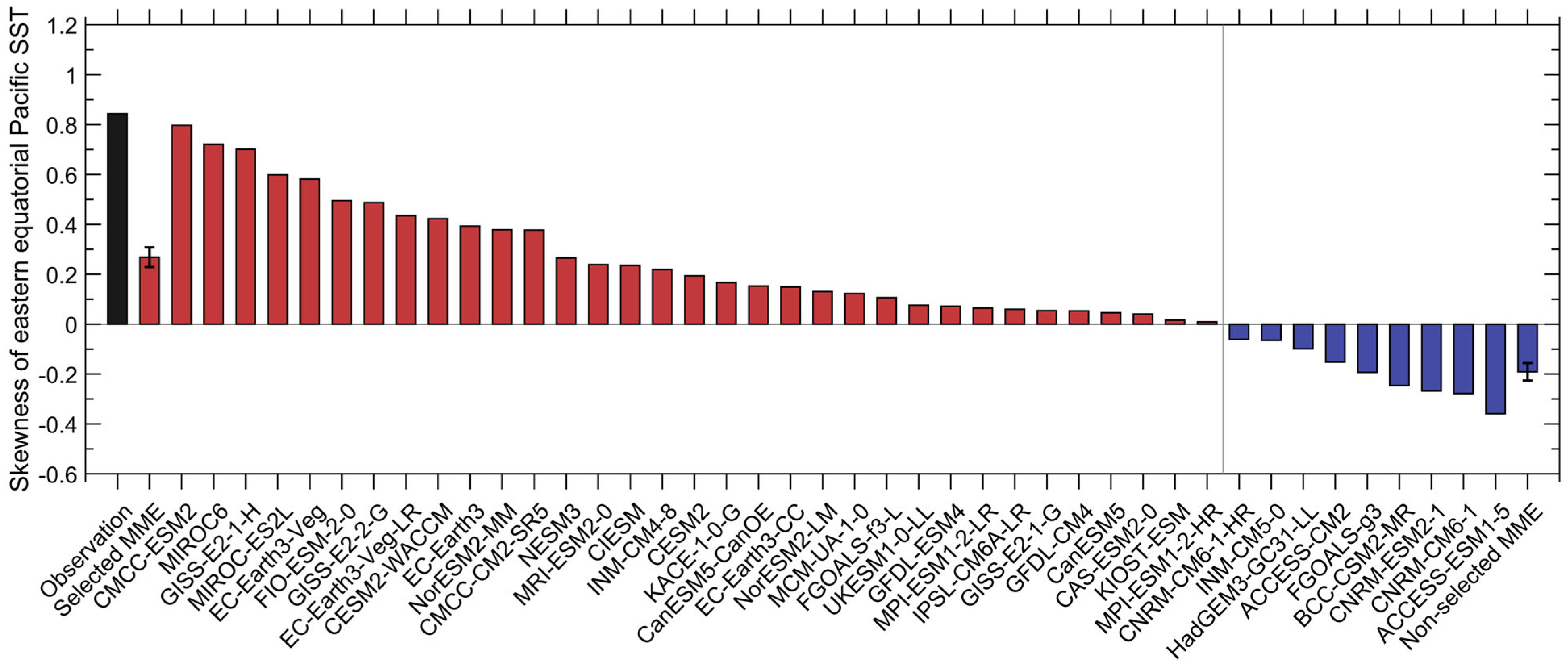
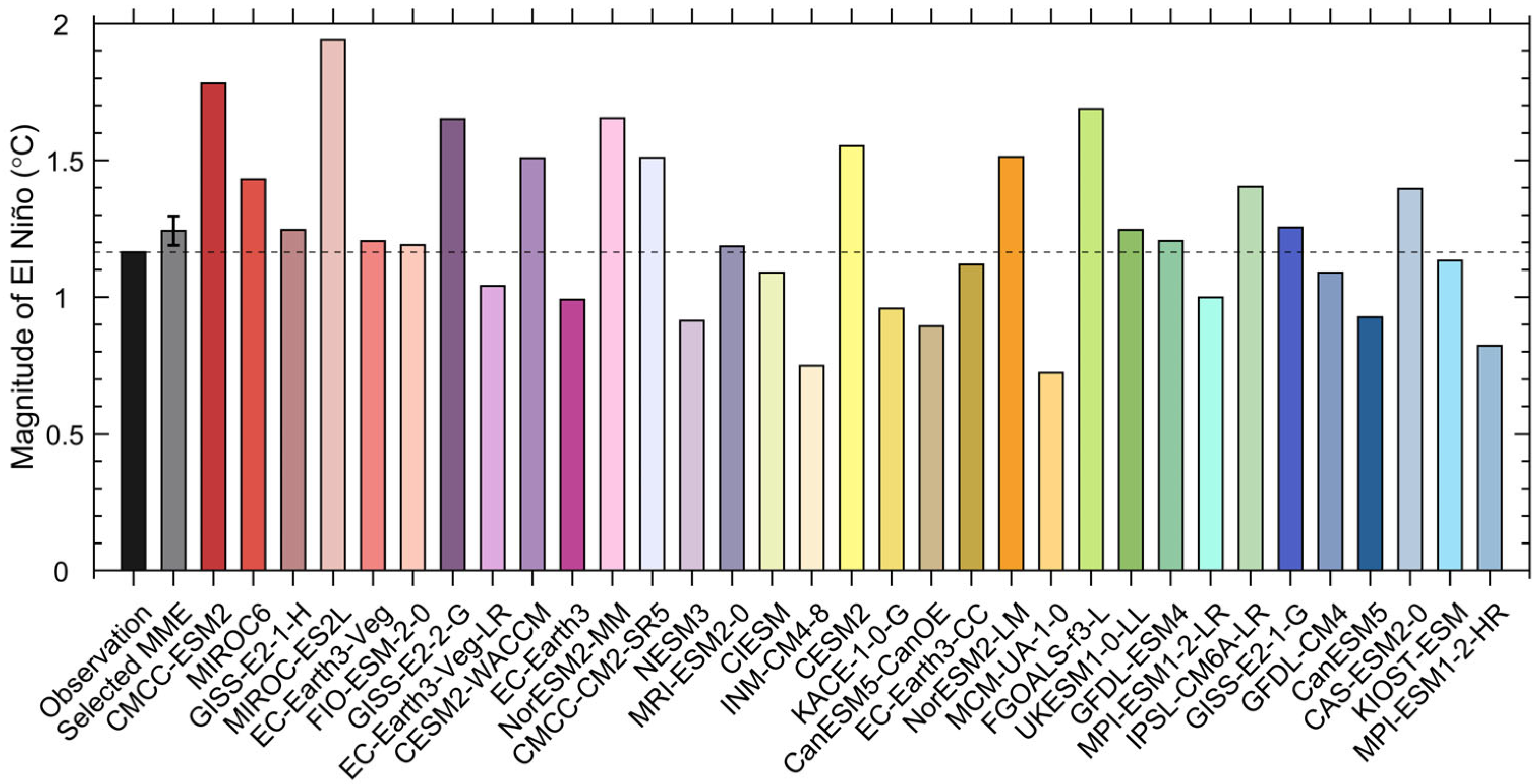
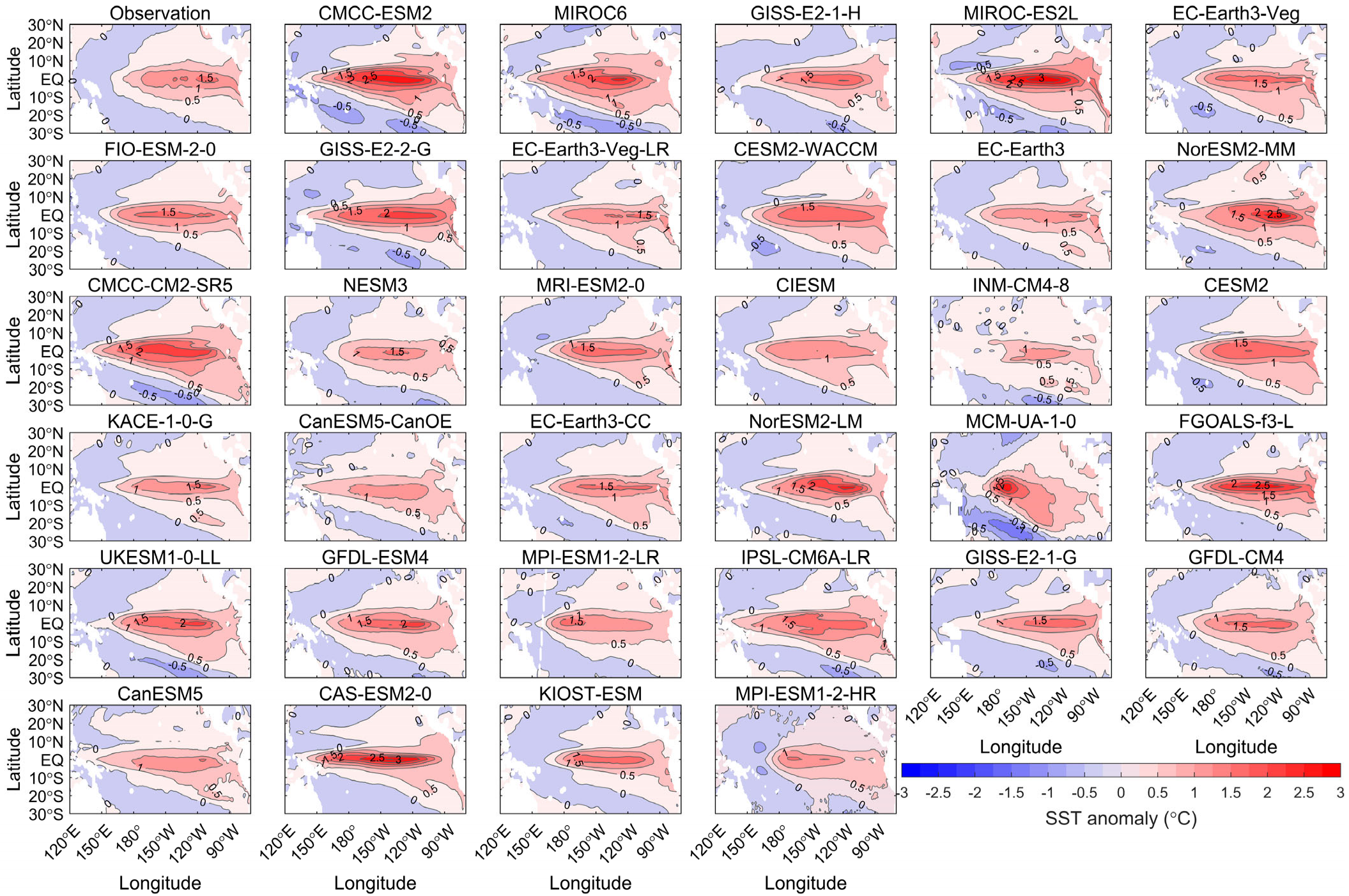


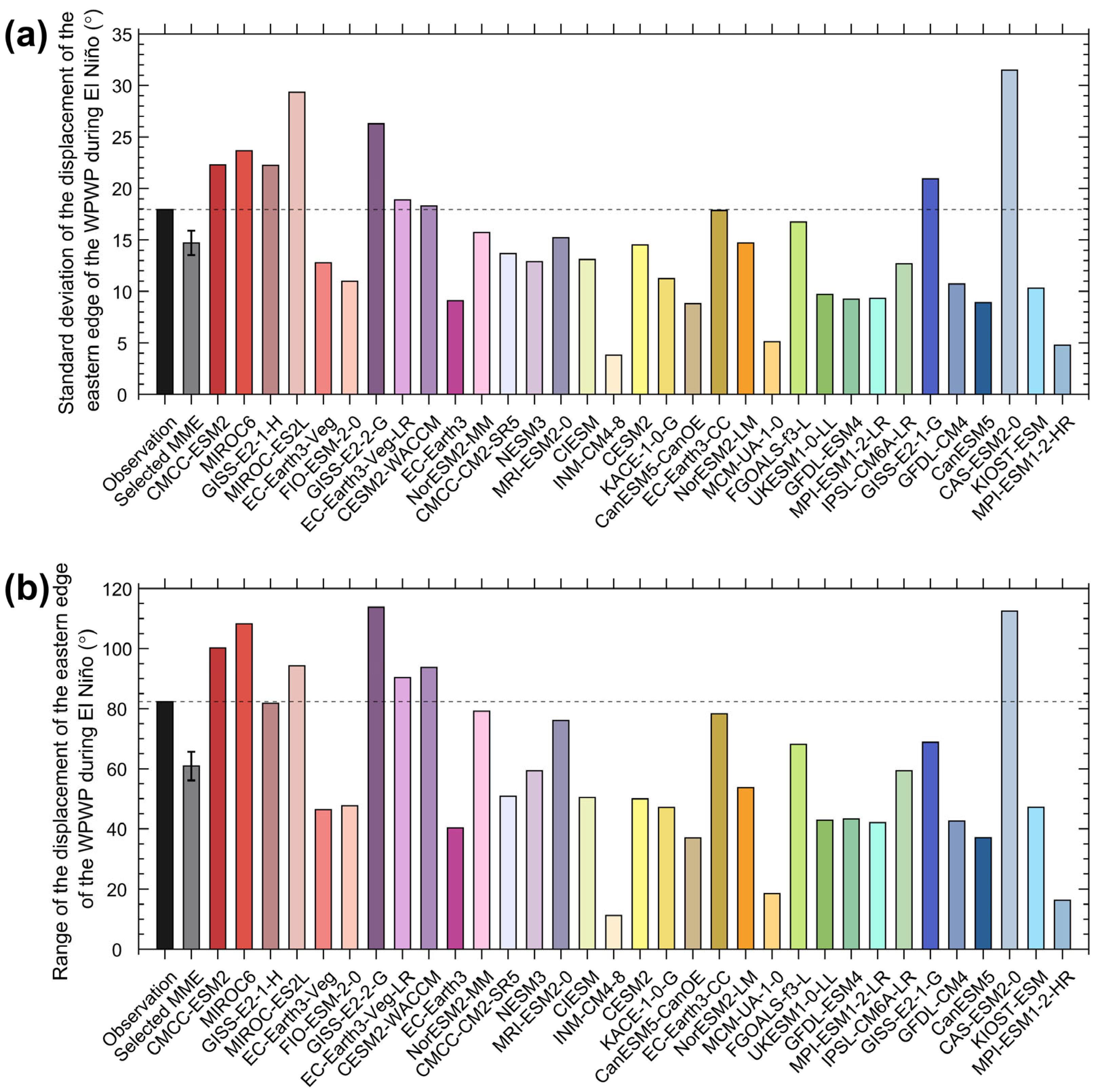

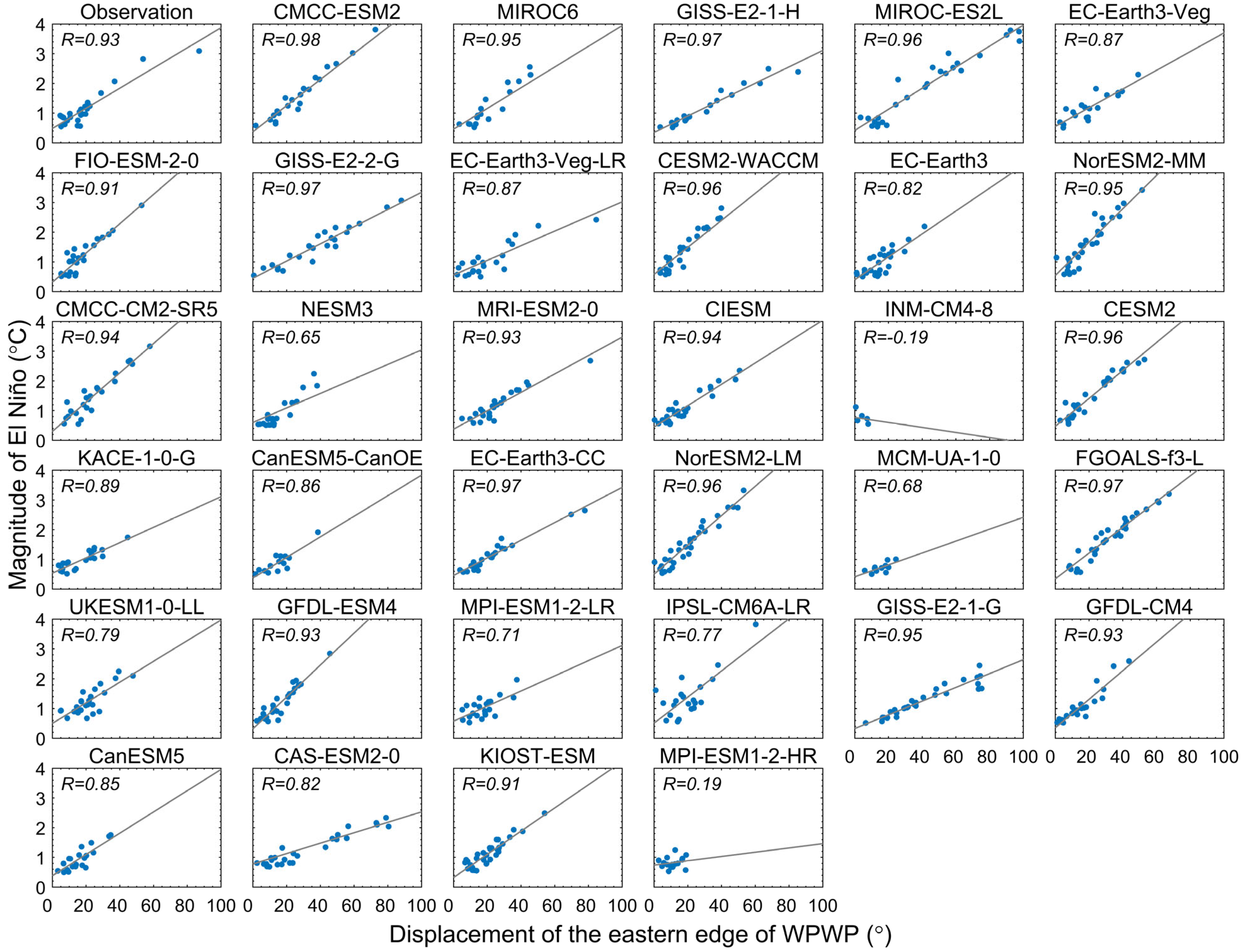

| Model Name | Realization | Skewness of the Eastern Equatorial Pacific SST | Selected or Not |
|---|---|---|---|
| ACCESS-CM2 | r1i1p1f1 | −0.15 | N |
| ACCESS-ESM1-5 | r1i1p1f1 | −0.36 | N |
| BCC-CSM2-MR | r1i1p1f1 | −0.25 | N |
| CanESM5 | r1i1p1f1 | 0.05 | Y |
| CanESM5-CanOE | r1i1p2f1 | 0.15 | Y |
| CAS-ESM2-0 | r1i1p1f1 | 0.04 | Y |
| CESM2 | r4i1p1f1 | 0.19 | Y |
| CESM2-WACCM | r1i1p1f1 | 0.42 | Y |
| CIESM | r1i1p1f1 | 0.24 | Y |
| CMCC-CM2-SR5 | r1i1p1f1 | 0.38 | Y |
| CMCC-ESM2 | r1i1p1f1 | 0.80 | Y |
| CNRM-CM6-1 | r1i1p1f2 | −0.28 | N |
| CNRM-CM6-1-HR | r1i1p1f2 | −0.06 | N |
| CNRM-ESM2-1 | r1i1p1f2 | −0.27 | N |
| EC-Earth3 | r1i1p1f1 | 0.39 | Y |
| EC-Earth3-CC | r1i1p1f1 | 0.15 | Y |
| EC-Earth3-Veg | r1i1p1f1 | 0.58 | Y |
| EC-Earth3-Veg-LR | r1i1p1f1 | 0.43 | Y |
| FGOALS-f3-L | r1i1p1f1 | 0.11 | Y |
| FGOALS-g3 | r1i1p1f1 | −0.19 | N |
| FIO-ESM-2-0 | r1i1p1f1 | 0.50 | Y |
| GFDL-CM4 | r1i1p1f1 | 0.05 | Y |
| GFDL-ESM4 | r1i1p1f1 | 0.07 | Y |
| GISS-E2-1-G | r1i1p1f2 | 0.05 | Y |
| GISS-E2-1-H | r1i1p1f2 | 0.70 | Y |
| GISS-E2-2-G | r1i1p3f1 | 0.49 | Y |
| HadGEM3-GC31-LL | r1i1p1f3 | −0.10 | N |
| INM-CM4-8 | r1i1p1f1 | 0.22 | Y |
| INM-CM5-0 | r1i1p1f1 | −0.06 | N |
| IPSL-CM6A-LR | r1i1p1f1 | 0.06 | Y |
| KACE-1-0-G | r1i1p1f1 | 0.17 | Y |
| KIOST-ESM | r1i1p1f1 | 0.02 | Y |
| MCM-UA-1-0 | r1i1p1f2 | 0.12 | Y |
| MIROC6 | r1i1p1f1 | 0.72 | Y |
| MIROC-ES2L | r1i1p1f2 | 0.60 | Y |
| MPI-ESM1-2-HR | r1i1p1f1 | 0.01 | Y |
| MPI-ESM1-2-LR | r1i1p1f1 | 0.06 | Y |
| MRI-ESM2-0 | r1i1p1f1 | 0.24 | Y |
| NESM3 | r1i1p1f1 | 0.27 | Y |
| NorESM2-LM | r1i1p1f1 | 0.13 | Y |
| NorESM2-MM | r1i1p1f1 | 0.38 | Y |
| UKESM1-0-LL | r1i1p1f2 | 0.08 | Y |
Disclaimer/Publisher’s Note: The statements, opinions and data contained in all publications are solely those of the individual author(s) and contributor(s) and not of MDPI and/or the editor(s). MDPI and/or the editor(s) disclaim responsibility for any injury to people or property resulting from any ideas, methods, instructions or products referred to in the content. |
© 2025 by the authors. Licensee MDPI, Basel, Switzerland. This article is an open access article distributed under the terms and conditions of the Creative Commons Attribution (CC BY) license (https://creativecommons.org/licenses/by/4.0/).
Share and Cite
Gu, Z.; Sun, D.-Z. El Niño Magnitude and Western Pacific Warm Pool Displacement. Part I: Historical Insights from CMIP6 Models. Atmosphere 2025, 16, 680. https://doi.org/10.3390/atmos16060680
Gu Z, Sun D-Z. El Niño Magnitude and Western Pacific Warm Pool Displacement. Part I: Historical Insights from CMIP6 Models. Atmosphere. 2025; 16(6):680. https://doi.org/10.3390/atmos16060680
Chicago/Turabian StyleGu, Zhuoxin, and De-Zheng Sun. 2025. "El Niño Magnitude and Western Pacific Warm Pool Displacement. Part I: Historical Insights from CMIP6 Models" Atmosphere 16, no. 6: 680. https://doi.org/10.3390/atmos16060680
APA StyleGu, Z., & Sun, D.-Z. (2025). El Niño Magnitude and Western Pacific Warm Pool Displacement. Part I: Historical Insights from CMIP6 Models. Atmosphere, 16(6), 680. https://doi.org/10.3390/atmos16060680





